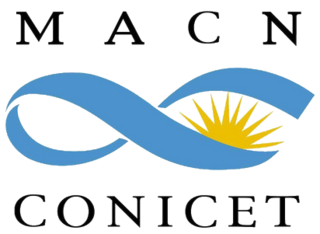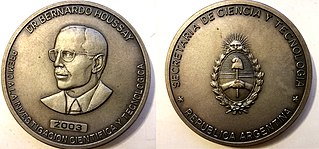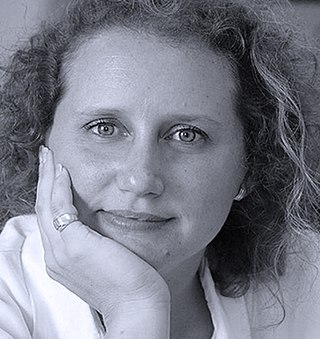
The University of Buenos Aires is a public research university in Buenos Aires, Argentina. Established in 1821, it is the premier institution of higher learning in the country and one of the most prestigious universities of Ibero-America. It has educated 17 Argentine presidents, produced four of the country's five Nobel Prize laureates, and is responsible for approximately 40% of the country's research output. The QS World University Rankings currently places the UBA at number 67, the highest ranking university in the Spanish-speaking world.
The Union of the Democratic Centre is a centre-right to right-wing conservative and economically liberal political party in Argentina. It was founded in 1982 by Álvaro Alsogaray who unsuccessfully run in the 1983 and 1989 presidential elections, and represented the conservative elite, technocrats, and classical liberals.

The Faculty of Exact and Natural Sciences, commonly and informally known as Exactas, is the natural science school of the University of Buenos Aires, the largest university in Argentina.

The Spanish settlement Nueva Colonia y Fuerte de Floridablanca was established in San Julian Bay in 1780 and abandoned four years later due to scurvy. The settlement was deliberately destroyed so the facilities could not be used by foreign powers.

Eduardo Braun-Menéndez was a noted Argentine physiologist.

The Bernardino Rivadavia Natural Sciences Argentine Museum is a public museum located in the Caballito section of Buenos Aires, Argentina.

Alberto Carlos Taquini was an Argentine cardiologist, clinical researcher and academic.
The Taquini Plan was a project for the restructuring of higher education in Argentina proposed by biochemist and academic Dr. Alberto Taquini in 1968. Implemented in 1970, it resulted in a significant decentralization of the Argentine national university system.

Federal Peronism, also known as Dissident Peronism is the faction or branch of either moderate, centrist or right-wing Peronism, that is currently identified mostly by its opposition to the ruling Kirchnerism, the left-wing faction of Peronism.

Eduardo Arzt is an Argentine molecular biologist, Master in Experimental Biology, Doctor (Ph.D) from the Faculty of Pharmacy and Biochemistry. Currently, he is a senior researcher at CONICET, distinguished professor of the Faculty of Natural Sciences of the University of Buenos Aires, External Scientific Member of the Max Planck Society (Germany) and director of the Biomedicine Research Institute of Buenos Aires – CONICET – Partner Institute of the Max Planck Society.

The Bernardo Houssay Award is a distinction awarded by Argentina's Ministry of Science, Technology and Productive Innovation to honor outstanding work by scientists and researchers. The Ministry selects recipients annually through a jury of prominent scientists. Presented by the President of Argentina, it is one of the country's most prestigious prizes in the field of science and engineering.

Sabina Andrea Frederic is an Argentine social anthropologist, university professor and politician. A specialist on military and security personnel, she was Argentina's Minister of Security from 2019 to 2021, in the cabinet of President Alberto Fernández.

The Institute of Social Sciences Research is an excellence research center of the Pontifical Catholic University of Argentina and Associated Unit of the CONICET located in Buenos Aires, Argentina, dedicated to research in the field of the social sciences and the humanities.

María Fernanda Beigel is an Argentine sociologist and scientist who develops her research at the crossroads between Bourdieu's reflexivity and the Latin American historical-structural tradition.
Rebeca Gerschman was an Argentinian biologist and physiologist who received a Ph.D. in Biochemistry and Pharmacy from the University of Buenos Aires. Known for her advances in the field of biochemistry, she was the first scientist to propose—in 1954—that free radicals contributed to oxygen toxicity and cell aging and death. After receiving two successive degrees in biochemistry and pharmacy, she achieved her Ph.D. in 1937. Her thesis was about the determination of potassium in plasma. Following her Ph.D., she began researching at the University of Rochester and published her famous paper on oxygen poisoning. She was the first to suggest that oxygen free radicals caused cell death and aging. After years of researching, Gerschman returned to the University of Buenos Aires and began teaching in the Physiology Department. She retired at the age of 77 from teaching and died several years later in 1986 from aplastic anemia.

Roberto Carlos Salvarezza is an Argentine biochemist, researcher and politician. He was Argentina's Minister of Science, Technology and Innovation from 2019 to 2021, in the cabinet of President Alberto Fernández.

The history of science and technology in Argentina covers scientific policies and discoveries made in the country.

Adriana Cristina Serquis is an Argentine physicist, the president of the National Atomic Energy Commission (CNEA), and principal researcher of the National Scientific and Technical Research Council (CONICET). In 2014, she received the L'Oréal-UNESCO National Award For Women in Science for her contribution to the rational use of electrical energy.
Olimpia Iris Lombardi is an Argentine philosopher of science whose research involves ontology in chemistry and in quantum mechanics, including the use of ontological pluralism to argue for treating chemistry as autonomous from, rather than subsidiary to, physics.

The Faculty of Medical Sciences, formerly and commonly known as the Faculty of Medicine, is the medical school of the University of Buenos Aires (UBA), the largest university in Argentina. Established in 1822 as one of the UBA's earliest divisions, FMED is presently the largest medical school in Argentina, with over 24,000 enrolled students as of 2011.















